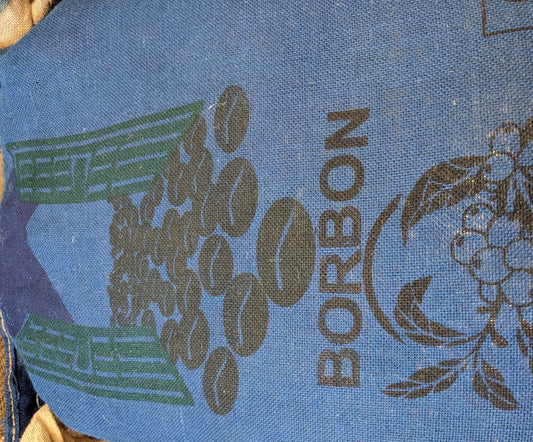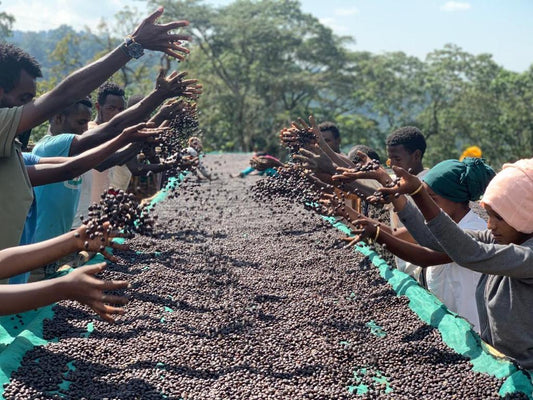If you've been noticing more and more unusual sounding processing methods around lately, you're not alone.
Demand for experimentally processed coffees continues to grow from strength to strength, with weird and wonderful flavour notes like "blue jolly rancher" and "bubble gum ice cream" that are just too intriguing to pass by.
And it's not just home baristas and coffee lovers either.
Experimental processing is also making a huge appearance on the competition circuit right now too.
Take this years World Barista Championships in Busan for example, where 4 out of the 7 finalists opted to bring an experimentally processed coffee as their competition coffee.
And...spoiler alert... one of them even won!
You can watch Mikael Jasin's winning routine here, if your're interested, to hear him talk more about the coffees he chose to compete with:
Even Ethiopia, which has long resisted the pull towards experimental processing, has started to shift.
"... when experimental Ethiopian coffees began to make waves in the competition circuit, and when Cup of Excellence began to operate in Ethiopia, the profit potential of experimental processing became clear. Now, minimum mandated prices for experimentally processed coffee have skyrocketed, more than doubling what they were a couple weeks ago. In fact, many producers have adjusted their strategies to focus exclusively or primarily on experimental processing lots." - Emily McIntyre, Catalyst Trade.
So what is experimental processing, exactly?
Experimental processing is a collective name given to any non traditional coffee processing method - i.e. anything other than washed, natural or honey process.
The term "experimental processing" spans a wide range of different methods of processing coffees, but usually they all involve some type of extended fermentation stage.
The ferment stage is the big common denominator, and it's the reason why experimental processing techniques have professionals and specialty coffee enthusiasts so divided.
But more on that a bit later on.
In experimental processed coffees, controlled fermentation is allowed to take place for varying lengths of time and sometimes in sealed containers with a limited oxygen supply.
This fermentation adds complexity to the flavour profile, and can often result in wilder flavour profiles that wouldn't be possible with traditional processing methods.
Some common experimental coffee processing techniques, explained
Here's a quick breakdown of the most common experimental processing labels you might see, and what each one actually means.
Aerobic
Aerobic fermentation is fermentation with oxygen present.
Coffee cherries are immersed in water and left in an open air tank.
Wild yeasts and microbes that are naturally present on the coffee cherries then metabolise the sugars present in the cherries.
This reaction produces new compounds that show up as new flavour notes.
Out of these 3 main types of fermentation that we're talking about today, aerobic fermentation is the most challenging to get right.
Being open air, additional natural yeasts and microbes in the atmosphere around the fermentation tanks will be drawn into the mix, speeding up the fermentation process.
Temperatures can also increase quite rapidly as the energy of the fermentation grows.
All of that means that the fermentation can very quickly escalate and go beyond too far, where it can show up as harsh vinegar acidity and even take away from other qualities like sweetness.
Anaerobic
Anaerobic fermentation processes are where the supply of oxygen is limited or even eliminated altogether.
Limiting the oxygen supply by fermenting in a contained environment, means that the microorganisms feed on the sugars more slowly.
This allows the producer to stretch out the fermentation time and give the microorganisms and wild yeasts more time in which to develop more slowly.
This can allow for more complex flavours to be developed.
It's also much easier for farmers and producers to control the fermentation process and not risk it running away from them and ruining the lot.
Carbonic Maceration
Carbonic maceration is a coffee processing method whereby ripe coffee cherries are placed in sealed tanks, and the tank is then pumped full with CO2 (carbon dioxide).
The pumped in CO2 creates a pressure build up in the tanks which pushes oxygen out.
The coffee cherries are placed in the tanks whole.
Common flavour characteristics of carbonic maceration processed coffees are winey, rich red fruits and stone fruits.
Taya Brown, an educator at Cafe Imports shares that "often carbonic maceration coffees have “intense flavor profiles, with boozy and cooked fruit flavors,”. Of course, some of them are sweeter, and some more acidic. If things don’t go right, “they also run the risk of astringency, dryness, and bitterness,” she adds.
The benefits of experimental processing methods
With experimental processing techniques like aerobic and anaerobic fermentation adding complexity to cup profiles and creating new flavour compounds, the benefits are potentially huge.
2015 World Barista Champion Sasa Sestic says in an interview with Perfect Daily Grind:
"“[Fermentation] is where we have increased, and also decreased, the quality of coffee, in some instances, by eight points.” When most specialty coffees cup somewhere between 80 and 92 points out of 100, eight points is a phenomenal difference.".
These processing techniques can be so effective at altering the coffees flavour profile, that they actually provide a great way for producers to add value to (and to enhance the value of) coffees that would otherwise be lower scoring.
Think, lower elevation coffees that would typically score low or struggle to qualify as specialty.
Experimental processing gives those farmers and producers an opportunity to enhance the desirability of their lots, command better prices and stand out where they might otherwise not have been able to.
Right now, we're still in a place where demand is high and supply is relatively low.
That means that good experimentally processed lots can command even higher prices for the producers who take the chance and work hard to make them happen.
That all sounds great. So what are the down sides?
Probably the biggest argument you might hear against experimental processing techniques, is that these techniques take away from or cover up the true origin and varietal characteristics.
Terroir and origin take a back seat to those wilder and more out there flavours that fermentation makes possible.
These processing methods can also easily be overdone.
It's easy to over ferment and ruin an otherwise decent lot.
Aerobic fermentation methods in particular, can quickly get away from you, and require careful monitoring.
Microbes and natural yeasts can easily get into the sugary cherries and fermentation can quickly have them grow out of control.
A little bit of fermentation can be a great thing. It's what gives experimentally processed coffees their unique and sometimes wilder flavour notes.
But too much fermentation can quickly have those wilder flavours start to venture into the unpleasant.
This is a fine line, and where exactly it's drawn is also one of the main criticisms some people have over experimental processing techniques as a whole.
Why are experimental processing techniques for coffee controversial?
For every couple of people who are excited for the whole new world of flavours that different experimental processing techniques are throwing up, there's another person who would argue that the flavours you're tasting here aren't actually from the coffee itself.
A coffee purist might argue that what you're tasting with those ice cream and jolly rancher flavour notes, is the ferment.
Then again, you could say something similar about natural processed coffees too. And some do.
As with everything in coffee, there's no right or wrong.
It comes down to what you personally prefer to drink and what flavours you like to taste in your cup.
If you love your coffee on the wilder side, go for it! We'll be adding some great experimental lots to our line up in the coming months.
And if you prefer a solid washed for a clean acidity or traditional natural for a fruity sweetness and floralilty, we've got you covered.





